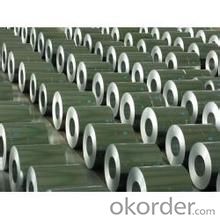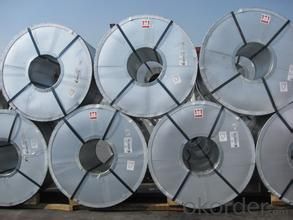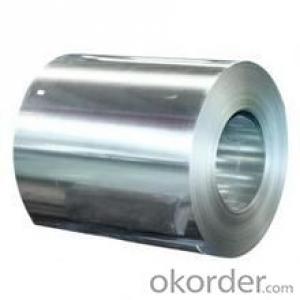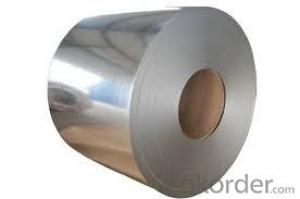good hot-dip galvanized/ auzinc Steel -SGCC in China
- Loading Port:
- Tianjin
- Payment Terms:
- TT OR LC
- Min Order Qty:
- 100 m.t.
- Supply Capability:
- 5000000 m.t./month
OKorder Service Pledge
OKorder Financial Service
You Might Also Like
Description:
Hot-dip aluzinc steel sheet is substrated on cold rolled steel (CRC) in various strength and specification. Coating composition is 55% aluminum in weight ratio, 43.4% zinc, and 1.5% silicon, with excellent corrosion and heat resistance performance.
Specifications:
1.Mateials:SGCC,DX51D / DX52D /S250,280GD
2.Size:width:600-1250mm(900mm,1215mm,1250mm,1000mm the most common)
thickness:0.15-2.0mm
length:1000-6000mm,as your require
3.Zinc coating :60-180g( as required)
4.Coil id:508mm
5.Coil weight: 3-5MT(as required)
6. Surface:regular/mini/zero spangle, chromated, skin pass, dry etc.
Applications:
Galvalume Coil widely used for roofing products, It is also the ideal base material for Prepainted Steel Coil.
1. roofing
2. gutters
3. unexposed automotive parts
4. appliances
5. furniture
6. outdoor cabinetry
Images:


Production of cold formed corrugated sheets and profiles for roofing, cladding, decking, tiles, sandwich walls, rainwater protective systems, air conditioning duct as well as electrical appliances and engineering.
- Q:What are the different coating options for steel coils?
- Steel coils have multiple options for coating, each with its own purpose and benefits. Some commonly used coatings for steel coils include the following: 1. Galvanized Coating: Steel coils are immersed in molten zinc, resulting in a zinc layer on the surface. This coating offers excellent corrosion resistance and protects against rust. It is ideal for harsh environments and moisture exposure. 2. Galvannealed Coating: This coating combines galvanizing and annealing processes. After galvanizing, the steel coils are annealed to create a zinc-iron alloy layer. Galvannealed coating provides enhanced paintability, weldability, and corrosion resistance. 3. Aluminum-Zinc Alloy Coating: Also known as Galvalume, this coating involves applying an aluminum-zinc alloy to the steel coils. It offers excellent corrosion resistance and heat reflectivity, making it suitable for roofing, siding, and automotive parts. 4. Organic Coatings: These coatings are typically applied as a top layer over a base coat of galvanized or galvannealed coating. Examples include paints, lacquers, and powder coatings. Organic coatings provide additional protection against corrosion, UV rays, and abrasion while enhancing the aesthetics of the steel coils. 5. Chromate Conversion Coating: This coating is commonly used as a pre-treatment before applying organic coatings. It improves adhesion between the steel surface and the organic coating, ensuring better corrosion resistance. The choice of coating depends on factors such as the intended application, environmental conditions, desired appearance, and budget. Manufacturers and end-users should carefully consider these factors to select the most suitable coating option for their specific requirements.
- Q:I am building a robot for Bots IQ. In doing so i have the option of building the the armor of my robot out of titanium or tool steel.. which would be the better option.Brief description of Bots IQ: It is a competition where 2 15lb robots go and attack each other with spinning blades, hammers or whatever is designed.
- I would have to say titanium , but in doing so I am having to assume you have access to some very serious machinery.This is because Ti is extremely difficult to work and also work hardens, which could lead to cracking and failure.The other problem is that Ti is also very hard to weld .It seems tool steel is the choice for ease of working and weldability, so unless you can buy the bits you need precut or made then I'd say tool steel,preferably something along the lines of ramax.Your other option is spring steel as this is workable and gets hardened after shaping.
- Q:How are steel coils used in the production of steel knobs?
- Steel coils are used in the production of steel knobs by being fed into a stamping machine, where they are cut into the desired shape and size. The coils provide a continuous supply of steel material, ensuring efficiency and consistency in knob production.
- Q:How are steel coils used in the manufacturing of hydraulic cylinders?
- Steel coils are used in the manufacturing of hydraulic cylinders as the raw material for creating the cylinder body. The steel is typically rolled into a coil form and then cut into specific lengths and shapes to construct the cylinder barrel. This allows for precise and durable construction of hydraulic cylinders, ensuring they can withstand high pressure and heavy loads.
- Q:like the steel industry and the effects it had on industrial growth, 10 points!
- The single most important important advance in steel production was learning to accurately control carbon content. This was done through the Bessemer Process in which air was blown through molten iron to burn out impurities and excess carbon. Low carbon iron (wrought iron) could be easily worked into shapes. Medium carbon iron could be cast into useful and durable shapes. High carbon steel could be used for structural uses (beams and girders). Adding alloys such as nickel and silicon could produce very tough steels and steels resistant to rust. Adding vanadium to steel engine parts allowed Ford to produce finely machined engines in huge numbers with existing machinery.
- Q:What are the common coil coating methods?
- The common coil coating methods include roll coating, curtain coating, and spray coating.
- Q:I have hundreds of pounds of scrap steel... who purchases this steel and what is the price per pound etc. of this? Does someone pick it up or do I bring it somewhere?
- It okorder /
- Q:Hello,I have been thinking about buying a Tungsten Carbide Diamond wedding band for my husband but one of my family members keep telling me that Tungsten Carbide is merely steel and hence, a low quality metal, therefore, I shouldn't buy it. I don't really know much about it. Please if anyone can tell me more about this metal? Thanks.
- Tungsten is not steel. Tungsten is a chemical element. What they do is add an alloy mixture to tungsten and it turns into Tungsten Carbide. You want to find a ring with a nickel alloy, some manufacturers cheap out and add cobalt instead. Make sure the ring you buy does not contain cobalt. Steel is an alloy consisting mostly of iron, with a carbon.
- Q:Can steel coils be recycled?
- Yes, steel coils can be recycled. Steel is a highly recyclable material, and the recycling process for steel coils involves melting them down and reshaping them into new products. This helps conserve natural resources, reduce energy consumption, and minimize waste.
- Q:How are steel coils processed for painting or coating?
- Steel coils are processed for painting or coating through a series of steps. First, the coils are cleaned and treated to remove any impurities, such as oil, dirt, or rust, using chemical treatments or mechanical methods like abrasive blasting. Then, a primer or base coat is applied to enhance adhesion and provide corrosion resistance. After drying, the topcoat or finishing coat is applied using various techniques like coil coating, electrostatic spraying, or powder coating. Finally, the coated steel coils undergo curing or baking at high temperatures to ensure proper adhesion and durability of the paint or coating.
1. Manufacturer Overview |
|
|---|---|
| Location | |
| Year Established | |
| Annual Output Value | |
| Main Markets | |
| Company Certifications | |
2. Manufacturer Certificates |
|
|---|---|
| a) Certification Name | |
| Range | |
| Reference | |
| Validity Period | |
3. Manufacturer Capability |
|
|---|---|
| a)Trade Capacity | |
| Nearest Port | |
| Export Percentage | |
| No.of Employees in Trade Department | |
| Language Spoken: | |
| b)Factory Information | |
| Factory Size: | |
| No. of Production Lines | |
| Contract Manufacturing | |
| Product Price Range | |
Send your message to us
good hot-dip galvanized/ auzinc Steel -SGCC in China
- Loading Port:
- Tianjin
- Payment Terms:
- TT OR LC
- Min Order Qty:
- 100 m.t.
- Supply Capability:
- 5000000 m.t./month
OKorder Service Pledge
OKorder Financial Service
Similar products
New products
Hot products
Related keywords






























